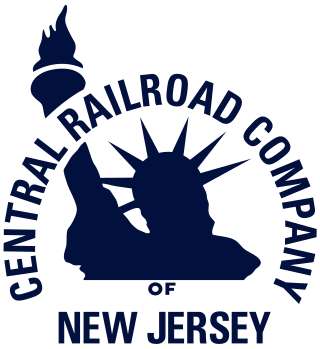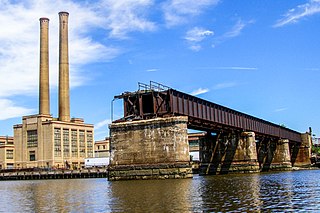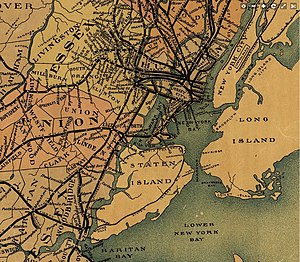
The BNSF Railway Bridge 5.1, also known as the St. Johns Railroad Bridge or the Willamette River Railroad Bridge, is a through truss railway bridge with a vertical lift that spans the Willamette River in Portland, Oregon, United States. Built by the Spokane, Portland and Seattle Railway (SP&S) and completed in 1908, it was originally a swing-span bridge, and its swing-span section was the longest in the world at the time. However, 81 years later the main span was converted from a swing-type to a vertical-lift type, in order to widen the navigation channel. The lift span is one of the highest and longest in the world. The bridge consists of five sections, with the two sections closest to the bank on each side fixed.

NJ Transit Rail Operations is the rail division of NJ Transit. It operates commuter rail service in New Jersey, with most service centered on transportation to and from New York City, Hoboken, and Newark. NJ Transit also operates rail service in Orange and Rockland counties in New York under contract to Metro-North Railroad. The commuter rail lines saw 57,179,000 riders in 2023, making it the third-busiest commuter railroad in North America and the longest commuter rail system in North America by route length.

The Central Railroad of New Jersey, also known as the Jersey Central, Jersey Central Lines or New Jersey Central, was a Class I railroad with origins in the 1830s. It was absorbed into Conrail in April 1976 along with several other prominent bankrupt railroads of the Northeastern United States.

For the purposes of this article, the Jersey City area extends North to Edgewater, South to Bayonne and includes Kearny Junction and Harrison but not Newark. Many routes east of Newark are listed here.
The Chemical Coast is a section of Union and Middlesex counties in New Jersey located along the shores of the Arthur Kill, across from Staten Island, New York. The name is taken from the Conrail Chemical Coast Line, an important component in the ExpressRail system serving marine terminals in the Port of New York and New Jersey.

A moveable bridge, or movable bridge, is a bridge that moves to allow passage for boats or barges. In American English, the term is synonymous with drawbridge, and the latter is the common term, but drawbridge can be limited to the narrower, historical definition used in some other forms of English, in which drawbridge refers to only a specific type of moveable bridge often found in castles.

The Raritan Valley Line is a commuter rail service operated by New Jersey Transit (NJT) which serves passengers in municipalities in Union, Somerset, Middlesex, Essex, and Hunterdon counties in the Raritan Valley region, primarily in central New Jersey and a smaller portion of northern New Jersey, in the United States. The line's most frequent western terminus is Raritan station in Raritan. Some weekday trains continue farther west and terminate at the High Bridge station, located in High Bridge. Most eastbound trains terminate in Newark; passengers are able to transfer to NJ Transit using a combined ticket or PATH and Amtrak to New York City. A limited number of weekday trains continue directly to New York.

The Aldene Connection is a connection between two railroad lines in the Aldene neighborhood of Roselle Park, New Jersey, United States, one formerly belonging to the Central Railroad of New Jersey (CNJ), the other formerly of the Lehigh Valley Railroad. The connections allow trains on the New Jersey Transit Raritan Valley Line to travel from Cranford and points west through stations in Roselle Park and Union to the Hunter Connection in Newark, which in turn allows access to the Northeast Corridor and Newark Penn Station.

The Central Railroad of New Jersey Terminal, also known as Communipaw Terminal and Jersey City Terminal, was the Central Railroad of New Jersey's waterfront passenger terminal in Jersey City, New Jersey. The terminal was built in 1889, replacing an earlier one that had been in use since 1864. It operated until April 30, 1967.

Cranford is an active commuter railroad station in the township of Cranford, Union County, New Jersey. Trains operate between High Bridge and Newark Penn Station on New Jersey Transit's Raritan Valley Line. The next station east is Roselle Park while west is Garwood. Cranford station contains two side platforms to service three tracks and is accessible for handicapped persons under the Americans with Disabilities Act of 1990.

On September 15, 1958, a Central Railroad of New Jersey (CNJ) morning commuter train, #3314, ran through a restricting and a stop signal, derailed, and slid off the open Newark Bay lift bridge in Newark Bay, New Jersey, United States. Both diesel locomotives and the first two coaches plunged into Newark Bay and sank immediately, killing 48 people and injuring 48 more. A third coach, snagged by its rear truck (bogie), hung precariously off the bridge for two hours before it also toppled into the water. As the locomotive crew was killed, the cause of the crash was never proven, though the lack of a "dead man's switch" may have contributed to the derailment.

Danforth Avenue station is a station on the Hudson–Bergen Light Rail (HBLR) in Jersey City, New Jersey. The station is located at the intersection of Danforth Avenue and Princeton Avenue in Greenville.

Dock Bridge is a pair of vertical lift bridges carrying Amtrak, NJ Transit, and PATH trains across the Passaic River at Newark, Essex County and Harrison, Hudson County, New Jersey, United States. It is the seventh crossing from the river's mouth at Newark Bay and is 5.0 miles (8.0 km) upstream from it. Also known as the Amtrak Dock Vertical Lift, it is listed on the New Jersey and National Registers of Historic Places.

The Upper Bay Bridge, or the Lehigh Valley Railroad Bridge, is a vertical lift bridge spanning the Newark Bay in northeastern New Jersey. It is used by CSX Transportation travelling through the North Jersey Shared Assets Area of the United States rail network along the National Docks Secondary line. The bridge is just north and parallel to the New Jersey Turnpike's Newark Bay Bridge. A notable train using the bridge is the Juice Train, which originates in Florida.

The Newark and New York Branch was a railway line that ran between Downtown Newark and the Communipaw Terminal at the mouth of the North River in Jersey City, bridging the Hackensack River and Passaic River just north of their mouths at the Newark Bay in northeastern New Jersey. The Central Railroad of New Jersey operated it from its opening in 1869. Through operations ended in 1946; portions remained in use until 1967.

The PD Draw is a partially dismantled railroad bridge on the Passaic River between Newark and Kearny in the US state of New Jersey. It was built as part of Central Railroad of New Jersey line known as the Newark and New York Branch. The swing bridge is the first crossing upstream from Newark Bay at mile point 1.2.
The Hackensack Drawbridge was a double-track railroad movable bridge across the mouth of the Hackensack River between Jersey City and Kearny, New Jersey. It was operational until 1946, when a steamship crashed into it.

The Dumbarton Rail Bridge lies just to the south of the Dumbarton road bridge. Built in 1910, the rail bridge was the first structure to span San Francisco Bay, shortening the rail route between Oakland and San Francisco by 26 miles (42 km). The last freight train traveled over the bridge in 1982, and it has been proposed since 1991 to reactivate passenger train service to relieve traffic on the road bridges, though this would entail a complete replacement of the existing bridge. Part of the western timber trestle approach collapsed in a suspected arson fire in 1998.






















